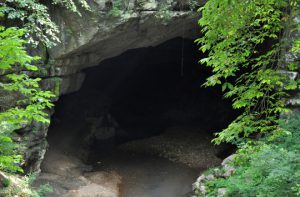
A study published in the journal, Antiquity, describes how a team of scientists used 3D photo mapping to recreate the tight crevices of a cave in Alabama and reveal etchings that had previously gone unnoticed.
Ancient rock art was usually done deep inside caves because the Native Americans believed the sacred spaces were pathways to the underworld.
Jan Simek, Professor of Anthropology at the University of Tennessee and his team, focused on a cave they called ‘Alabama’s 19th Unnamed Cave.’ The cave is located on a private property.
The entrance of the cave has a small stream flowing out of it. The entrance is about 32ft tall and 50ft wide. This stream flowing for years explains the absence of any etchings or artifacts. Past the entrance is a large chamber, and even further is three miles of underground pathways.
In the late 1990s, the chamber where scientists first observed cave art had a really low ceiling. Researchers had to crawl or crouch just to get through. The tightest spots were just about 2ft tall. There was also no natural light, so flashlights had to be used to explore the space. This was what started the trend of researchers setting up cameras and taking pictures of what they thought was a typical cave ceiling.
This new study uses 3D photogrammetry that was first introduced in 2017. Its objective is to take pictures that overlap by 60%-80%. A computer program then blends these images and enables the user manipulate the distance to add dimension.
In the past, this method was used to document artifacts or provide virtual reality experiences for important sites around the world. ‘The potential of photogrammetry for discovery and analysis through the digital manipulation of spaces, however, has not yet been explored in archaeology,’ the study’s authors wrote.
The researchers spent two months taking 16,000 pictures to study the 19th Unnamed Cave. Their software allowed them to recreate the cave in three dimensions, and move the distance between the ceiling and floor. When they lowered the cave floor, a wider view of the ceiling became visible and they were able to see hundreds of etchings that were not visible in person.
A Native American artist had used his/her fingertip or an etching tool to design the layer of mud which covered the cave ceiling. Most of the etchings were anthropomorphs. These creatures resembled human beings, and the researchers believe they were depictions of spirits in the underworld.
For example, one etching depicted a figure with both bird and human characteristics. It had a square, human-like head, long arms, and shoulders, with its bottom flared with tail feathers. Its torso was covered in some form of design, which might have been a type of regalia or a piece of clothing.
During their survey of the cave, the researchers collected several pieces of pottery shards from the cave floor. These assisted them in dating the cave art to the middle-to-late Woodland period (1000 B.C. to A.D. 1600). They were unable to identify the anthropomorphs however, because there was no correspondence with any recorded oral histories or documented archaeological materials.
The researchers believe that the size of the etchings was important. The larger the depiction, the greater the importance of the spirit to their belief system. The large size of the human-bird anthropomorphs compared to other nearby etchings of snakes, insects and other figures, suggests that it was more important than the others.
The authors came to the conclusion that 3D photogrammetry should be used generally in cave explorations to fully map the floors, ceilings and walls. They wrote that, ‘We believe that this technique can revolutionize the study of rock art.’
By Marvellous Iwendi.
Source: Discover